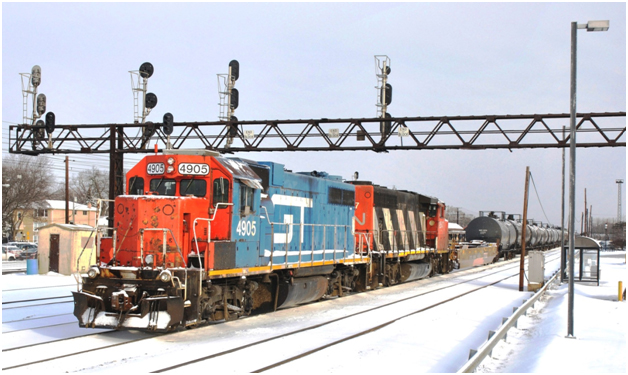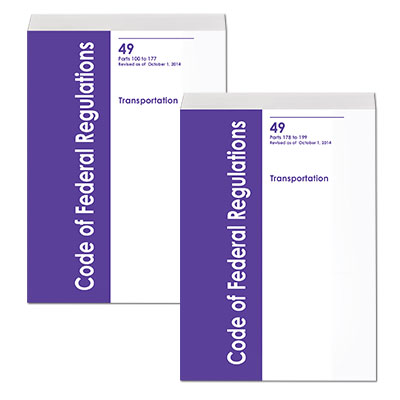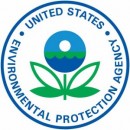
The FRA’s newly proposed rulemaking will affect many trains carrying hazardous materials, particularly in tank cars, on both main line tracks and near rail yards, like this Canadian National train exiting Markham Yard in Homewood, Illinois. (Copyright 1/2012 by Paul Burgess, used with permission)
At approximately 1:15 AM EST on July 6th, 2013, a unit freight train of the cross-border operating Montreal, Maine, & Atlantic Railroad (MM&A) loaded with crude oil from the Bakken Shale Formations in North Dakota in the western United States suffered a failure of its automatic and manual braking systems while left unattended and presumably safely secured on the MM&A mainline track near the town of Nantes in provincial Quebec in Canada.
The uncrewed train then proceeded to “run away” in an uncontrolled and accelerating descent of the 1.2% downhill grade on which it had been left tied down, and at an estimated speed of over 60 mph entered a 10 MPH speed restricted curve in the city center of the town of Lac-Mégantic some seven miles from the train’s starting point for the runaway. Tragically, much of the train derailed and multiple cars loaded with crude oil ruptured, caught fire, and exploded in the heart of the community. The resultant massive fires and sustained release of hazardous chemicals combined to kill or leave missing forty-seven Canadian citizens of the town, injured countless others, and destroyed or contaminated much of the city center and nearby lake in a disaster for which recovery efforts continue.
A year later the associated investigation, including the ongoing criminal prosecution in Canada of several MM&A employees involved in the accident, continues also; however, much sooner than that, based on initial study and with the grave consequences of the accident all too apparent in Lac-Mégantic , on August 2nd 2013 the United States Department of Transportation’s (USDOT) Federal Railroad Administration (FRA) issued an EMERGENCY ORDER (EO) directing US railroads to take certain actions intended to forestall the likelihood of such an incident occurring again. See this link:
http://www.fra.dot.gov/eLib/details/L04722
The order was effective immediately and included the following major provisions (Note: the language below is transcribed directly from the order):
- No train or vehicles transporting specified hazardous materials can be left unattended on a mainline track or side track outside a yard or terminal, unless specifically authorized.
- In order to receive authorization to leave a train unattended, railroads must develop and submit to FRA a process for securing unattended trains transporting hazardous materials, including locking the locomotive or otherwise disabling it, and reporting among employees to ensure the correct number of hand brakes are applied.
- Employees who are responsible for securing trains and vehicles transporting such specified hazardous material must communicate with the train dispatchers the number of hand brakes applied, the tonnage and length of the train or vehicle, the grade and terrain features of the track, any relevant weather conditions, and the type of equipment being secured.
- Train dispatchers must record the information provided. The dispatcher or other qualified railroad employee must verify that the securement meets the railroad’s requirements, and they must verify that the securement meets the railroad’s requirements.
- Railroads must implement rules ensuring that any employee involved in securing a train participate in daily job briefings prior to the work being performed.
- Railroads must develop procedures to ensure a qualified railroad employee inspects all equipment that an emergency responder has been on, under or between before the train can be left unattended.
- Railroads must provide this EO to all affected employees.
On September 9th, 2014, the FRA issued a notice of proposed rulemaking (NPRM) under Docket # FRA-2014-0032 Notice No.1 that if made final as is, would codify into regulation most of the major provisions of the previous emergency order. Here is the link to the NPRM:
http://www.gpo.gov/fdsys/pkg/FR-2014-09-09/pdf/2014-21253.pdf
While many of these provisions are seemingly common-sense, and indeed are already part of the operating procedure at many railroads in one form or another (or have been made so since the issuance of EO 28), several of the requirements may lead to increased costs and/or operating complications as railroads modify their operations to comply with the staffing and control requirements imposed. Provisions in the proposed rule do exempt certain small railroads (i.e. Class III railroads, or what are commonly known as short lines) from some of the provisions.
Check Out Labelmaster’s Selection of Ground Transportation Publications, Including the Early 49 CFR, Government 49 CFR and MasterRegs™ 49 CFR
One major change appearing in the NPRM is a proposal to change the definition of “Yard Limit” to “Yard.” Despite its seemingly innocuous nature, this may have a major impact on operations on smaller or less traveled lines, since at present some entire sections of railroad are classified and operated as “Yard Limits” and this designation allows for a certain easing of operating rules regarding travel over routes so designated. The change in definition will restrict much of that activity. FRA also includes a provision regarding the setting and releasing of air and manual brake systems while trains are left briefly unattended during active switching operations; this provision should help railroads comply during routine operating activities with what otherwise might be a very restrictive and time-consuming set of procedures which are actually designed for and intended to safeguard trains that have been tied down—railroad parlance for “parking” their equipment. The proposed new rules would apply to trains with at least one loaded car carrying a material poisonous by inhalation as defined in US 49 CFR 171.8, or at least twenty loaded cars carrying Class 2.1, 3, 1.1, or 1.2 materials, or a Hazardous Substance as listed in US 49 CFR 173.31(f)(2). Another provision would mandate that locomotives leading such trains have control cabs capable of being locked, and/or that their “reverser handle,” a key control device without which the locomotive’s drive systems cannot be engaged, be removed and safely secured—one should note that reverser handles are designed to be removed and that most railroads already impose this rule as well as a requirement to lock the control cab on exit on their operating employees. A further requirement mandates inclusion of much of the above into a job briefing for crews when they are involved with such activity.
The requirements of last summer’s Emergency Order 28 and now this associated proposed rulemaking do impose certain operational restrictions on railroads that did not previously exist, and to a degree one might consider that they represent an enlarged FRA presence “in the cab” as a consequence. However, given the dire consequences of the accident so clearly on display amid the wreckage at Lac-Mégantic, railroaders and all transporters of hazardous materials can expect continued increased scrutiny regardless of their individual safety performance.
Labelmaster is a full service provider of goods and services for the Hazardous Materials and Dangerous Goods professional, shippers, transport operators, and EH&S providers. See our full line of solutions at www.labelmaster.com.



